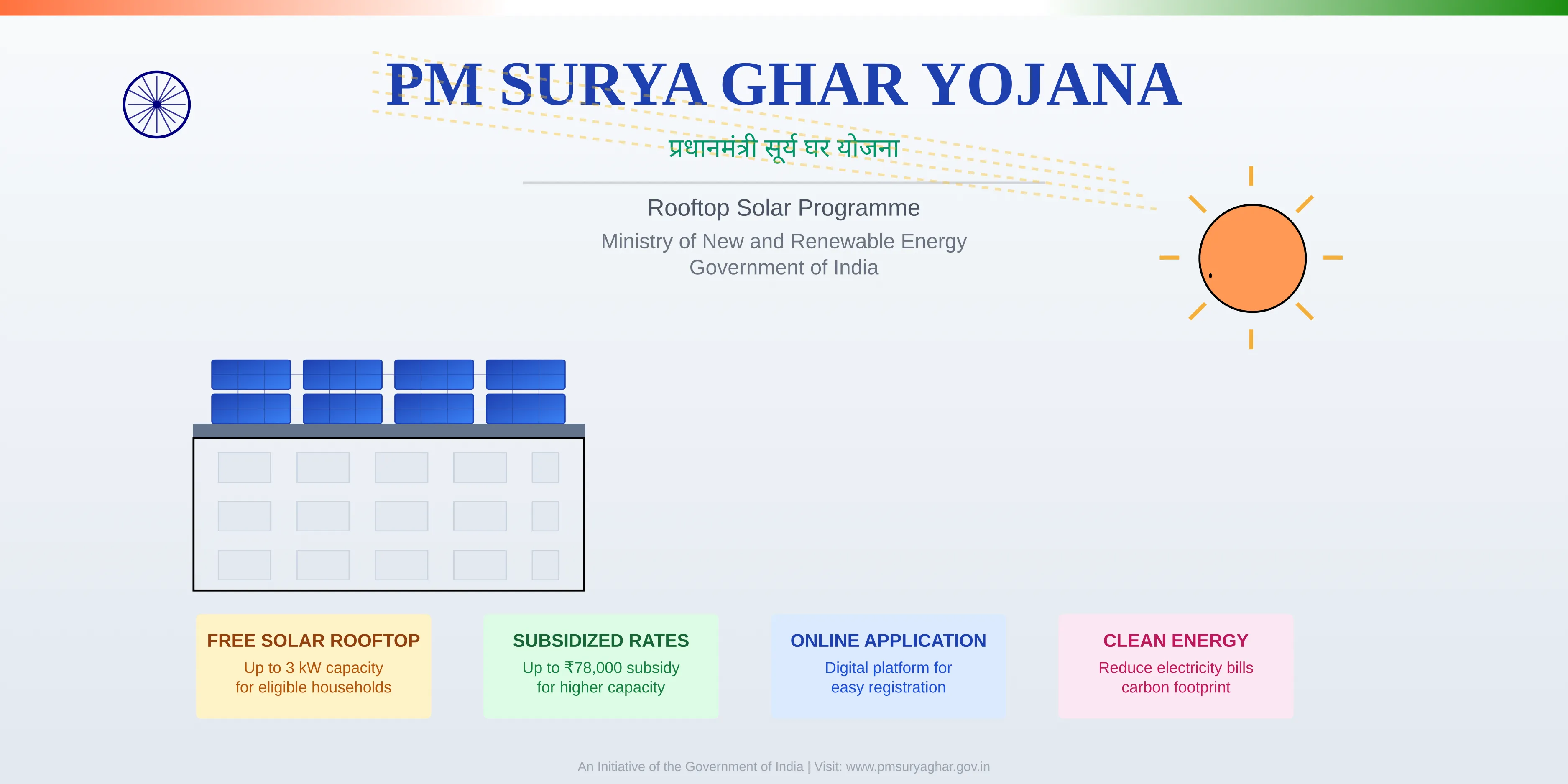PM Surya Ghar Solar Subsidy Scheme
The PM Surya Ghar Muft Bijli Yojana: A Step Towards Sustainable Energy
The Indian government’s PM Surya Ghar Muft Bijli Yojana, launched in 2024, is a groundbreaking initiative aimed at providing free rooftop solar panels to eligible households across the country. This scheme is designed to empower citizens with clean, renewable energy while reducing electricity bills and promoting energy independence.
In line with India’s commitment to renewable energy, the scheme ensures that households can easily transition to solar power, reducing dependence on traditional fossil fuels and supporting the country’s long-term sustainability goals. The implementation of this scheme also aligns with the government’s vision to reduce carbon footprints and create a greener environment for future generations.

Subsidy Details for PM Surya Ghar
Subsidy for Residential Households
Subsidy for GHS/RWA
The scheme provides a substantial subsidy for the installation of rooftop solar systems in eligible households.
The subsidy is directly credited to the bank account of eligible beneficiaries after installation. The scheme supports a wide range of system capacities to cater to different household energy needs, thus making solar energy accessible for a larger section of society.
Eligibility Criteria
To qualify for the PM Surya Ghar scheme, the following eligibility conditions must be met:
- Applicants must be the owners of a residential property where the solar panels will be installed.
- The property must have a valid electricity connection.
- The roof space should be suitable for the installation of solar panels, free from any shading or obstructions.
- Applicants should not have previously availed of any other government subsidy for rooftop solar installation.
Step-by-Step Application Process
Applying for the PM Surya Ghar Muft Bijli Yojana involves several easy steps. Here’s a simple guide:
- Registration: Visit the official portal PM Surya Ghar and complete the registration process with personal details, Aadhar number, and property information.
- Document Submission: Upload the necessary documents, including proof of property ownership, latest electricity bill, and Aadhar card.
- Feasibility Check: A representative from your local electricity distribution company (DISCOM) will assess the feasibility of installing the solar panels at your location.
- Installation: Once the feasibility is confirmed, choose an empanelled solar vendor to install the solar system. The vendor will coordinate with you for a seamless installation.
- Inspection & Net-Metering: After installation, the DISCOM will inspect the system and activate net-metering, allowing you to send excess power back to the grid.
- Subsidy Disbursement: After the system is commissioned and the net-metering is set up, the subsidy amount will be transferred to your bank account.
Costs and Savings
The installation cost of the solar system varies depending on the system size and other factors. Below is an estimate of the cost based on system capacity, including the subsidy:
| System Size (kW) | Estimated Cost Before Subsidy (₹) | Subsidy Amount (₹) | Final Cost After Subsidy (₹) |
|---|---|---|---|
| 2 kW | ₹1,44,000 | ₹60,000 | ₹84,000 |
| 3 kW | ₹1,99,000 | ₹54,000 | ₹1,45,000 |
| 5 kW | ₹3,35,000 | ₹78,000 | ₹2,57,000 |
Once the solar panels are installed and operational, homeowners can expect significant savings on their electricity bills. In addition to savings, solar energy contributes to reducing carbon emissions, making it a sustainable and eco-friendly choice.
Bank Loan Availability
Low-cost EMI facility is available from nationalised banks and leading financial institutions for the installation of rooftop solar systems. This makes it easier for homeowners to adopt solar energy without bearing the entire upfront cost. The loan process is simple and can be availed with minimal documentation. Our team will guide you through the loan application process, ensuring you get the best possible financing options to suit your needs.
Additional Information on Solar Power Plants
For each 1 kWp of solar power plant, approximately 100 square feet of shade-free area is required, with direct sunlight and preferably facing South. East/West orientations are also suitable, with South being the most recommended.
Average price of solar power plants ranges between ₹63,000 to ₹73,000 per kWp. The expected monthly production is approximately 90-120 units per kWp, depending on sunlight availability and system efficiency.
Savings from Solar Power Plants
The savings from solar power installations are significant. For example, the savings from a 2 kWp on-grid system can range from ₹2200 to ₹2700 over a two-month period, depending on factors like location and energy consumption. The savings increase with system size, as shown below:
| Ongrid Solar Capacity | Bimonthly Savings in KSEBL Bills (₹) |
|---|---|
| 2 kWp | ₹2200-2700 |
| 3 kWp | ₹4700-5200 |
| 5 kWp | ₹9200-10200 |
| 10 kWp | ₹18,200-20,200 |
It is important to note that solar energy production and savings are highly dependent on solar irradiance and weather conditions, so actual results may vary.
PM Surya Ghar in Kerala
Kerala has been actively pursuing solar energy projects as part of its broader green energy initiatives. The state has successfully implemented several solar power projects, aiming to make renewable energy accessible to its citizens. Under the PM Surya Ghar Muft Bijli Yojana, Kerala residents can benefit from subsidies for rooftop solar systems, significantly reducing their energy costs. The government has also partnered with local electricity distribution companies to simplify the installation process and ensure seamless integration of solar power into the grid. Additionally, Kerala’s energy policies focus on increasing the adoption of solar power in both urban and rural areas. These efforts are part of the state’s ambitious plan to meet its renewable energy targets, reduce dependence on non-renewable resources, and contribute to the national goal of achieving sustainable energy independence. Through such projects, Kerala is setting a strong example of environmental leadership.
